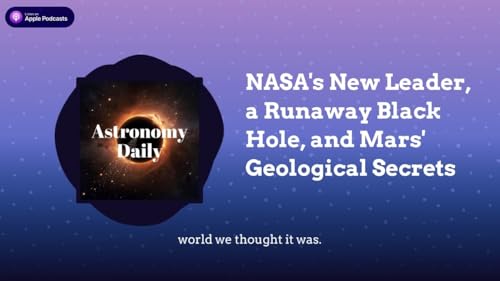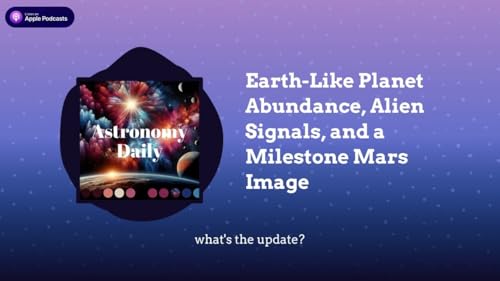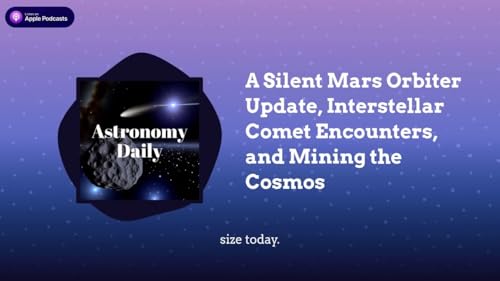In today's episode, we cover a wide array of intriguing updates from the cosmos, including a concerning communication loss with NASA's MAVEN spacecraft at Mars and the implications of its potential silence for ongoing research. We also highlight a successful rendezvous between two private spacecraft, showcasing advancements in autonomous orbital technologies. Additionally, we discuss the upcoming close approach of interstellar comet 3I Atlas, the fascinating discovery of primordial "dinosaur stars" by the James Webb Space Telescope, and the stunning visuals from the recent Gemin meteor shower. Finally, we explore the future of asteroid mining and its potential to revolutionize space exploration and resource sustainability.
### Timestamps & Stories
01:05 – **Story 1: MAVEN Spacecraft Communication Loss**
**Key Facts**
- NASA's MAVEN spacecraft has lost communication, with a brief signal indicating unexpected rotation.
- MAVEN plays a critical role in studying Mars' atmosphere and relaying communications for surface rovers.
03:20 – **Story 2: Successful Private Spacecraft Rendezvous**
**Key Facts**
- Starfish Space and Impulse Space executed an autonomous rendezvous in Earth orbit, a significant step for satellite servicing.
- The project, named Remora, showcases rapid development from concept to execution.
05:45 – **Story 3: Interstellar Comet 3I Atlas Approaches Earth**
**Key Facts**
- The comet is set to make its closest approach on December 19th, providing a rare observational opportunity.
- Telescopes like Hubble and ESA's JUICE will be studying its composition.
08:00 – **Story 4: Discovery of Dinosaur Stars**
**Key Facts**
- JWST may have found evidence of massive primordial stars, potentially up to 10,000 times the mass of our Sun.
- These stars could explain the rapid formation of supermassive black holes in the early universe.
10:15 – **Story 5: Gemin Meteor Shower Highlights**
**Key Facts**
- The Gemin meteor shower peaked on December 13, showcasing bright meteors from asteroid 3200 Phaethon.
- Astrophotographers captured stunning images from around the world.
12:00 – **Story 6: Future of Asteroid Mining**
**Key Facts**
- Research suggests small asteroids could provide essential resources for Moon and Mars missions.
- The potential for water extraction and the economic implications of space resource ownership are discussed.
### Sources & Further Reading
1. NASA (https://www.nasa.gov/)
2. James Webb Space Telescope (https://www.jwst.nasa.gov/)
3. European Space Agency (https://www.esa.int/)
4. Space.com (https://www.space.com/)
5. Science Daily (https://www.sciencedaily.com/)
### Follow & Contact
X/Twitter: @AstroDailyPod
Instagram: @astrodailypod
Email: hello@astronomydaily.io
Website: astronomydaily.io
Clear skies and see you tomorrow! 🌟
Become a supporter of this podcast: https://www.spreaker.com/podcast/astronomy-daily-space-news-updates--5648921/support (https://www.spreaker.com/podcast/astronomy-daily-space-news-updates--5648921/support?utm_source=rss&utm_medium=rss&utm_campaign=rss) .
Sponsor Details:
Ensure your online privacy by using NordVPN . To get our special listener deal and save a lot of money, visit You'll be glad you did!
Become a supporter of Astronomy Daily by joining our Supporters Club. Commercial free episodes daily are only a click way... Click Here (https://www.spreaker.com/podcast/astronomy-daily-space-news-updates--5648921/support)
This episode includes AI-generated content.
Episode link: https://play.headliner.app/episode/30676077?utm_source=youtube
 10 m
10 m 11 m
11 m 19 m
19 m Dec 19 202535 m
Dec 19 202535 m 10 m
10 m 10 m
10 m 27 m
27 m 11 m
11 m
